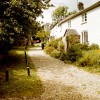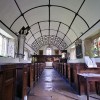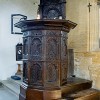Nowadays Clavell Tower is available as a holiday let. This article was first published on the original Dorset Ancestors web-site when the plans for saving the tower were first discussed.
The wealthy need to show off their riches; nowadays a collection of fast cars, a private jet or at the very least a helicopter will do the trick, but in times past, the building of a folly fulfilled the need. These usually tall buildings very often had no purpose other than to be seen, and today we benefit from a legacy of eccentric structures that have become part of the landscape and an important part of our heritage.
For one of Dorset’s follies, The Tower of the Winds or Clavell Tower, as it is better known, perched perilously close to the edge of Hen Cliff at Kimmeridge, time is running out. The sea and the weather are conspiring to erode the ground from under its foundations and consign it to a watery grave. Unless help arrives soon the tower will slip over the edge and fall into the sea.
The cavalry is on its way led by The Landmark Trust, a building conservation charity founded 40 years ago to rescue and restore architecturally interesting and historic buildings. The trust’s projects sometimes take years to complete but here they know they are joined in a race with the elements against time.
On inheriting the Smedmore Estate in 1817 the Reverend John Richards changed his name to Clavell. It was not long before he started work on what has been described as a sun house, a lookout, an observatory and folly, completing the building in 1830; he died in 1833. The tower, visible for miles around, commands magnificent views of a stretch of Dorset’s coastline awarded World Heritage Site status.
Built of brick and rubble covered with stucco and with ashlar dressings the circular tower comprises three storeys above a semi-basement. A colonnade, for which the basement forms a projecting landing, surrounds the first stage. The upper stages are divided by a moulded stringcourse, and at the top is a cornice with a parapet. Each stage has four round headed windows providing panoramic views of the sea and countryside.
Thomas Hardy used it as a frontispiece for his Wessex Poems and courted Eliza Nicholls here. It caught the imagination of P.D. James for her novel The Black Tower and she auctioned a signed first edition to raise funds for the project.
The Landmark Trust plans to move the structure 25 metres inland – brick-by-brick. The project will take a year to complete and then probably for the first time, it will have a real purpose. To meet the costs for its future upkeep the tower is to be-let as holiday accommodation and there will be periods during the year when the tower will be open to schools and the public with displays detailing the tower’s history.
Planning permission and listed building consent having been granted. An award of £436,700 from the Heritage Lottery Fund added to £121,918 already raised sees the project ready to proceed and 80% funded. The total cost of the project is £714,297. £155,679 is still needed before work can start and you can help by sending a donation to The Landmark Trust, Shottesbrooke, Maidenhead, Berkshire.



